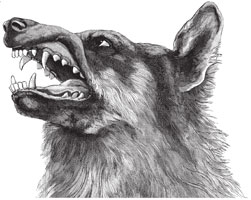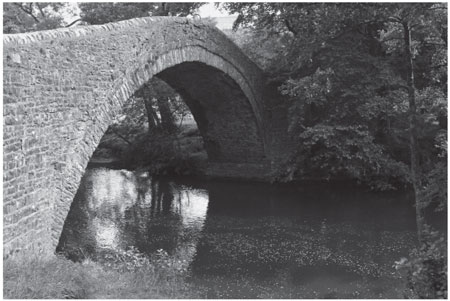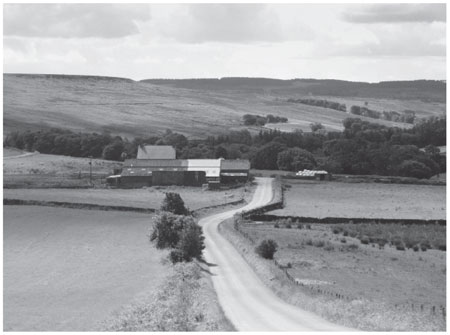Folklore of Yorkshire (17 page)
Read Folklore of Yorkshire Online
Authors: Kai Roberts

Inevitably, unscrupulous characters took advantage of the dread surrounding such harbingers and faked manifestations were not unknown. Felgreave Wood near Huddersfield was once known as the haunt of ‘a dog possessing a human head and a beard stretching from ear to ear’ and in the mid-nineteenth century a woman named Elizabeth Haigh supposedly fainted after witnessing this ‘monstrosity’, to be found the following day in a dire condition. However, it transpired that the local gamekeepers were merely exploiting an existing legend and dressing in sheepskins to crawl around the woods at night as a deterrent against superstitious poachers!
Meanwhile, the wags of Threshfield in Wharfedale thought it a great lark to dress a particularly large goat in a rattling chain, and let it loose to roam the lanes at night, much to the terror of farmers returning from the market at Kettlewell. It is said that one notoriously dishonest individual encountered the creature and fearing it was a barguest, got down on his knees and begged God to deliver him, promising to mend his ways in the future. He eventually managed to evade the disguised goat and was from that time considerably more honourable in his dealings – at least until he discovered the truth of the ruse.
Phantom hounds, and associated apparitions, seem to have been held in such fear that ‘nothing more effectively cleared the streets by night than the report that t’guytrash was out.’ Even in relatively populous centres such as Leeds or Skipton, a rumour that the padfoot was abroad would deter people from venturing any distance alone in the dark. In more lonely, rural areas there were often spots – such as the Rudgate at Walton or a bridge near Parlington – that were considered no-go areas after sunset.
Antiquarians initially seem to have perceived the phantom hound as an urban phenomenon. The earliest recorded instances in Yorkshire are the barguest of York and the padfoot of Pontefract, whilst an especially intimidating example was chronicled around Wakefield in 1766 – described as ‘shagged like a bear, as big as a calf, strange horns of unusual form, clanking a chain from one of its hind legs.’ It seems that during the eighteenth century, nearly every city street had its own guardian barguest, padfoot, guytrash or skriker, each as distinctive as the thoroughfare itself.
However, as the nineteenth century wore on, folklorists grew less and less interested in the industrialised urban areas and focused their attention primarily on rural populations, believing that ancient lore survived most authentically in places unsullied by technological advancement. As a result, towards the end of that century, the printed evidence suggests that phantom hounds had forsaken their municipal haunts for the tranquillity of the countryside. It is difficult to tell if this purely reflects the bias of the collectors or changing beliefs amongst the urban masses. Certainly some correspondents seem to suggest the latter. The guytrash was said to have left Horton when the district was incorporated, as it had grown ‘jealous of the policemen’!

In towns, the phantom hound seems to have been regarded as the
genius loci
of individual streets. It especially appears to have been associated with districts of ill-repute. For instance, the barguest of York favoured the vicinity of the prison and the gallows, whilst in Almondbury, the padfoot was believed to haunt the area around the ‘gang doors’, notorious in the town as a gathering place for ruffians and ne’er-do-wells. As such, the malevolent hound embodies the character of the locale and the belief performs a social function by deterring respectable citizens from straying too close to these dens of iniquity.
Similarly, in rural areas the phantom hound is often found in connection with dangerous places. The barguest of Trollers Gill in Wharfedale is a fine illustration of this relationship and writer, Edmund Bogg, spells it out in the story of an acquaintance travelling to Skyreholme at night during a storm:
Amid the roar of the elements he was completely lost. In fear and trembling, hurrying onwards, not knowing whither, two more steps and he would have dropped 100 feet into a boiling torrent below. But, at that moment … a brilliant flash of lightning illumined the scene – sufficient to disclose the hideous chasm. Shuddering with horror, he managed to drag himself from the brink; then falling to the ground, he lay until the storm had spent its fury. In the grey dawn … he managed to drag himself home, profoundly glad to have escaped the jaws of the Spectral Hound.
In Bogg’s narrative, the precipitous limestone gorge is the barguest and vice-versa, and a slavering, demonic hound certainly makes an appropriate personification of this forbidding landscape. Equally, phantom hounds are frequently recorded in close proximity to hazardous bodies of water – old ponds, wells, river-crossings and the like. J. Horsfall Turner notes that in the West Riding, the guytrash was often seen to retreat into rivers or pools of water, and believed the name ‘guytrash’ came from the splashing sound of its feet.
At Kirk Deighton in North Yorkshire, a black dog was thought to walk around the village pond at the time of the full moon, whilst at Thornton near Bradford, a guytrash known as the Bloody Tongue would emerge from Jim Craven’s Well and stalk down to the stream to drink. It was memorably described as ‘a great dog with startling red eyes, a tail as big as the branch of a tree and a lolling tongue that dripped blood. When he drank from the beck the water ran red right past the bridge.’
Moreover, such watery locations were not just physically perilous, but spiritually so as well. In pre-modern thought, water – especially water-crossings and springs that emerge mysteriously from the earth – was regarded as fundamentally liminal. To a holistic worldview, which comprehends much in terms of correspondences and sympathies, such material thresholds were also perceived as less-corporeal boundaries, where this world presses close against the Other. Consequently they were considered prime spots for unearthly encounters, and precisely the sort of place an entity like the phantom hound was most likely to lurk.

Ivelet Bridge in Swaledale, guarded by a phantom hound. (Kai Roberts)
The barguest that was sometimes seen on Ivelet Bridge across the River Swale in North Yorkshire, seemed to embody all the most common associations of the phantom hound motif. Not only did it haunt an ancient water-crossing, but the bridge was once a stopping point on a corpse way from Upper Swaledale to the parish church at Grinton. There is even a stone built into the bridge on which coffins were rested. The phantom hound was said ‘to glide silently on to the bridge and disappear over the ledge’ and unsurprisingly, a sighting of this particular example was widely regarded as ‘a sign of some tragic event to come’.
For the most part, however, a first-hand sighting of the phantom hound seems to have been a rare thing. The Victorian antiquarians, topographers and folklorists who recorded these beliefs were mostly of the opinion that they were already dying out, and any actual eyewitness accounts (or ‘memorates’) tended to be the experiences of deceased relatives, friends-of-friends, or had occurred many decades earlier and were recalled dimly through the haze of memory. Mostly phantom hounds were recorded only as ‘rumour legends’, firmly attached to some specific locale and superstition, but devoid of any more extensive narrative.
There are rare exceptions, of course. The legend of Trollers Gill is an obvious example, but this largely conforms to a migratory legend-type found throughout Britain, in which a sceptical (and often inebriated) individual sets out to confront a supernatural phenomenon which is widely feared in the neighbourhood and swiftly comes to regret it. Some more unique examples exist, but it is often difficult to tell to what extent they were genuine local legends and to what extent they were embellished or romanticised by their collectors, using elements of conventional ghost lore. The following example invokes so many folkloric tropes that it seems a little too self-consciously crafted to be ‘authentic’. However, it is also one of the most remarkable and macabre legends in the canon of Yorkshire folklore, and is worth relating in full for that reason.
The narrative takes place around Goathland on the North York Moors ostensibly in the early medieval period, as the local lord, Julian de Mauley, is described as somebody who still subscribed to the pagan religion of the Vikings. Julian was a particularly ruthless and despised ruler who, prior to the construction of his new castle at Julian Park, decided to secure its future stability through the ancient custom of foundation sacrifice. To this end, he seized a beautiful maiden called Gytha and instructed that she be walled up alive in the base of the castle, forcing her father Gundrun to do the job. In a final act of cruelty, Julian provided Gytha with a spinning-wheel to while away the time until her inevitable death, jibing that a woman must be kept busy until her very end.
The following year, on the eve of the anniversary of the sacrifice, unearthly cries began to reverberate through the castle walls from their foundations. As Julian lay in his chamber, they grew louder and louder, seeming to draw ever closer, until at last a white wraith clutching a spindle manifested at the foot of his bed. Insensible with terror, the tyrant could only lay there whilst the apparition began to bind his legs with thread from her spindle. Although the fibres were invisible, he was unable to break them and the next morning, long after the spirit had departed, he found he remained permanently lame.
Each year on that grim anniversary, the spectre would visit Julian; binding a little more of his body with that supernatural thread and each year, the paralysis and pain grew worse. Neither medical intervention, nor confession of sin, brought him respite – even his conversion to Christianity and construction of a new church in Goathland was in vain. Eventually, after a decade or so, his entire body had succumbed to the affliction and he finally expired, wracked with pain and no longer able to draw breath.
At first, the people of Goathland thought their troubles had finally come to an end: the brutal Julian de Mauley was dead and they were finally free from his reign of terror. However, shortly after his demise, a new terror began to stalk the countryside thereabouts, especially the vicinity of the new church. The fiend was described as ‘a gigantic black goat, with eyes that burned like live coals and horns tipped with fire’, and whosoever encountered this guytrash was seized by a mysterious malady and died in a matter of days. Its origin was unclear, but many believed it was the spirit of Julian de Mauley perpetuating his evil from beyond the grave.
Meanwhile, the dreadful cries of the spinning ghost still echoed from Julian’s abandoned castle and always seemed to foretell the death of a local girl. The beleaguered locals initially turned to the Church for help but to no avail, and their predicament grew so grave that they were forced to consult a local witch, known as the Spaewife of Fylingdales. She did not give her advice easily but hinted that the only way to be permanently rid of these two demons was to set them against each other. To this end, the villagers dug a large hole on the moors nearby and, knowing that the guytrash so often appeared in conjunction with death, they performed a mock funeral, placing the straw effigy in a coffin at the bottom of the excavation. For the spinning banshee, they laid a trail of honey, corn and salt from the castle to the pit for her to follow.
